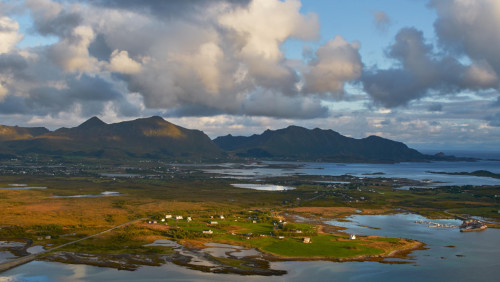English
Autumn or summer? September in Norway broke almost all records

In the photo: sunset over one of the Lofoten islands. Fot. Adobe Stock, licencja standardowa (zdjęcie poglądowe)
In September 2025, Norway experienced exceptionally high temperatures. The national average was 2.2°C above normal, and in the northern region, the month was classified as 'extremely warm.' In measurement records dating back to 1901, only September 2016 (2.4°C above normal) and 1999 (2.3°C) were warmer.
In all parts of the country, September temperatures exceeded the norm, but the most dramatic deviations from the average were recorded in northern Norway. According to the Norwegian Meteorological Institute, more than 80 stations in the region set heat records. Maximum values resembled summer. In towns such as Værnes (Trøndelag) and Bardufoss (Troms), there were as many as 15 and 10 September days with temperatures above 20°C.
Across the country, precipitation was also higher than usual, averaging 10 percent above normal. In some places, the differences reached over 100 percent.
Across the country, precipitation was also higher than usual, averaging 10 percent above normal. In some places, the differences reached over 100 percent.
Weather anomalies in the Arctic
Anomalies were recorded in Arctic areas. The Jan Mayen station recorded an average temperature of 6.9°C, which was 2.4°C above normal, and the highest precipitation—127.6 mm—62 percent above average. Stations in Ny-Ålesund, Bjørnøya, and Svalbard Airport also reported above-average temperatures (from 1.8 to 2.3°C above normal).
Among the coldest places, meteorologists pointed to Gaustatoppen (2.4°C) as well as Juvvasshøe and Juvflye. Even there, values remained above normal.
Among the coldest places, meteorologists pointed to Gaustatoppen (2.4°C) as well as Juvvasshøe and Juvflye. Even there, values remained above normal.
Rainy and dry at the same time
September was dominated by dry conditions, although locally there were very heavy downpours, especially in the regions of Austlandet, Agder, and Rogaland, with record stations such as Søyland (429.0 mm) and Helland (408.9 mm). In these areas, precipitation reached even 70-130 percent above normal.
Meteorological stations such as Skjåk II (22.5 mm) and Blanktjernmoen (22.9 mm) recorded precipitation much lower than average, by 14 and 44 percent respectively.
Meteorological stations such as Skjåk II (22.5 mm) and Blanktjernmoen (22.9 mm) recorded precipitation much lower than average, by 14 and 44 percent respectively.
The exceeding of long-term average temperatures across the country and the setting of records, especially in northern Norway and the Arctic, show that September 2025 fits into the broader context of climate change. Meteorologists emphasize that this is yet another year in which the summer season extends into the period traditionally known as autumn.
Dodaj komentarz
Wyślij


